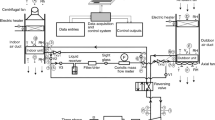Abstract
Improving HVAC performance is of paramount importance to sustain passenger comfort in a car. Numerical analysis of a three-dimensional model predicts a detailed description of fluid flow and temperature distribution in the passenger compartment and on the inside surface of the windshield. During the winter, the highest temperature is observed on the lower part of the windshield and in the vicinity of the defroster nozzle. Defrosting performance was excellent when the injection angle of the defrost nozzle was between 15 to 25 degrees with a standard distance ratio of one. During the cooling period, it was found that the temperature and humidity decrease to a comfortable range almost linearly at the initial stage. The numerical predictions are in good agreement with the experimental results.
Similar content being viewed by others
References
Anon (2005). SC/Tetra User’s Guide. Software Cradle Co., Ltd.
Aroussi, A. and Aghil, S. (2000). Characterisation of the flow field in a passenger car model. Optical Diagnostics in Engineering 4,1, 1–15.
Aroussi, A., Hassan, A. and Morsi, Y. S. (2003). Numerical simulation of the airflow over and heat transfer through a vehicle windshield defrosting and demisting system. Heat and Mass Transfer, 39, 401–405.
Brewster, R. A., Frik, S. and Werner, F. (1997). Computational analysis of automotive windshield de-icing with comparison to test data. SAE Paper No. 971833, London & New York.
Hara, J., Fujitani, K. and Kuwahara, K. (1988). Computer simulation of passenger compartment airflow. SAE Paper No. 881749.
Ishihara, Y., Hara, J., Sakamoto, H., Kamemoto, K. and Okamoto, H. (1991). Determination of flow velocity distribution in a vehicle interior using a visualization and computation techniques. SAE Paper No. 910310.
Lee, J.-G., Jiang, Y., Przekwas, J. and Sioshansi, M. (1994). Validation of computational vehicle windshield de-icing process. SAE Paper No. 940600.
Lee, K. B., Jean, H. H. and Youn, Y. M. (2006). Temperature distribution characteristics of automobile interior when operating the HVAC system in the summer. Proc. KSME Autumn Annual Conf., 1763–1768.
Lee, K. B., Jean, H. H. and Youn, Y. M. (2007). A Numerical Study on Automobile Interior Environment. The Report of Cooperative Research Industry with University. New University for Regional Innovation. 22–53.
Lin, C. H., Han, T. and Koromilas, C. A. (1992). Effects of HVAC design parameters on passenger thermal comfort. SAE Paper No. 920264.
Park, W. G., Park, M. S. and Jang, K. L. (2006). Flow and temperature analysis within automobile cabin by discharged hot air from defrost nozzle. Int. J. Automotive Technology 7,2, 139–143.
Stouffer and Sharkitt (1987). Air Sweep Defroster. Patent No. US 464485.
Author information
Authors and Affiliations
Corresponding author
Rights and permissions
About this article
Cite this article
Kader, M.F., Youn, Y.M., Jun, Y.D. et al. Characterization of the HVAC performance with defroster grillers and instrument panel registers. Int.J Automot. Technol. 10, 305–312 (2009). https://doi.org/10.1007/s12239-009-0035-z
Received:
Revised:
Published:
Issue Date:
DOI: https://doi.org/10.1007/s12239-009-0035-z




